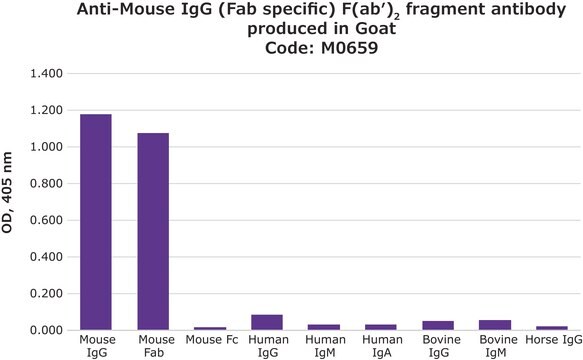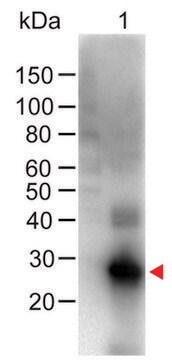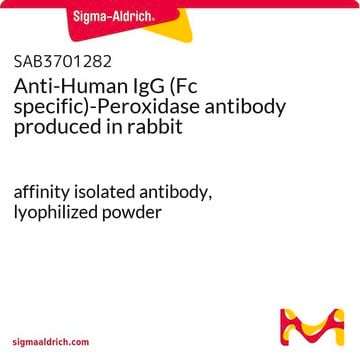I3266
Anti-Human IgG (Fab specific), F(ab′)2 fragment antibody produced in goat
affinity isolated antibody, buffered aqueous solution
Synonym(s):
F(ab′)₂ IgG
Sign Into View Organizational & Contract Pricing
All Photos(2)
About This Item
Recommended Products
biological source
goat
conjugate
unconjugated
antibody form
affinity isolated antibody
antibody product type
secondary antibodies
clone
polyclonal
form
buffered aqueous solution
technique(s)
quantitative precipitin assay: 2.0 mg/mL
shipped in
dry ice
storage temp.
−20°C
target post-translational modification
unmodified
General description
Immunoglobulins (Igs) belongs to immunoglobulin super-family (IgSF). Igs in general, consist of two heavy (H) chains and two light (L) chains. The L chain can be either κ or a λ chain. Each chain contains one NH2-terminal “variable" (V) region and one or more COOH-terminal “constant” (C) regions. Each of which consists of two sandwiched β pleated sheets ′pinned′ together by a disulfide bridge. There are five main classes of Igs based on heavy chain C domains, they are, IgM, IgG, IgA, IgD, and IgE isotypes. IgG can be divided into four subclasses, IgG1, IgG2, IgG3, and IgG4. Each subclass possesses distinct biologic properties.
Application
Anti-Human IgG (Fab specific), F(ab′)2 fragment antibody produced in goat has been used in enzyme linked immunosorbent assay (ELISA) and biosensor methodology.
Biochem/physiol Actions
IgG antibody subtype is the most abundant of serum immunoglobulins of the immune system. It is secreted by B cells and is found in blood and extracellular fluids and provides protection from infections caused by bacteria, fungi and viruses. Maternal IgG is transferred to fetus through the placenta that is vital for immune defense of the neonate against infections.
Immunoglobulin G (IgG) is digested by papain and yields two Fab fragments, each of which can bind antigen, and a single Fc fragment. IgG is split by pepsin splits into an Fc fragment and a single dimeric F(ab)2 that can cross-link as well as bind antigens.
Physical form
Solution in 0.01 M phosphate buffered saline, pH 7.4, containing 0.05% sodium azide as preservative
Disclaimer
Unless otherwise stated in our catalog or other company documentation accompanying the product(s), our products are intended for research use only and are not to be used for any other purpose, which includes but is not limited to, unauthorized commercial uses, in vitro diagnostic uses, ex vivo or in vivo therapeutic uses or any type of consumption or application to humans or animals.
Not finding the right product?
Try our Product Selector Tool.
Storage Class Code
10 - Combustible liquids
WGK
nwg
Flash Point(F)
Not applicable
Flash Point(C)
Not applicable
Personal Protective Equipment
dust mask type N95 (US), Eyeshields, Gloves
Certificates of Analysis (COA)
Search for Certificates of Analysis (COA) by entering the products Lot/Batch Number. Lot and Batch Numbers can be found on a product’s label following the words ‘Lot’ or ‘Batch’.
Already Own This Product?
Find documentation for the products that you have recently purchased in the Document Library.
Customers Also Viewed
An integrated solution for rapid biosensing with robust linker free covalent bindingsurfaces
Yin Y, et al.
Biosensors And Bioelectronics, 42, 447-452 (2013)
Functional analysis of the broadly neutralizing human anti-HIV-1 antibody 2F5 produced in transgenic BY-2 suspension cultures
Sack M, et al.
Faseb Journal, 21(8), 1655-1664 (2007)
Structure and function of immunoglobulins.
Schroeder Jr H W and Cavacini L
The Journal of Allergy and Clinical Immunology, 125(2), S41-S52 (2010)
S Hashira et al.
Pediatrics international : official journal of the Japan Pediatric Society, 42(4), 337-342 (2000-09-15)
Maternal immunoglobulin G (IgG), transferred across the placenta to the fetus during intrauterine life, is an important component of the neonatal immunological defence mechanisms against infection. There is controversy with respect to differences in placental transfer of the different IgG
Our team of scientists has experience in all areas of research including Life Science, Material Science, Chemical Synthesis, Chromatography, Analytical and many others.
Contact Technical Service














